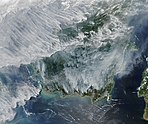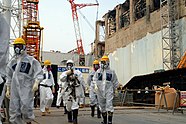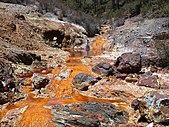Environmental issues are disruptions in the usual function of ecosystems.[1] Further, these issues can be caused by humans (human impact on the environment)[2] or they can be natural. These issues are considered serious when the ecosystem cannot recover in the present situation, and catastrophic if the ecosystem is projected to certainly collapse.
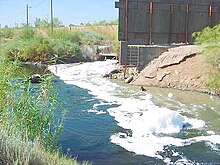
Environmental protection is the practice of protecting the natural environment on the individual, organizational or governmental levels, for the benefit of both the environment and humans. Environmentalism is a social and environmental movement that addresses environmental issues through advocacy, legislation education, and activism.[3]
Environment destruction caused by humans is a global, ongoing problem.[4] Water pollution also cause problems to marine life.[5] Most scholars think that the project peak global world population of between 9-10 billion people, could live sustainably within the earth's ecosystems if human society worked to live sustainably within planetary boundaries.[6][7][8] The bulk of environmental impacts are caused by excessive consumption of industrial goods by the world's wealthiest populations.[9][10][11] The UN Environmental Program, in its "Making Peace With Nature" Report in 2021, found addressing key planetary crises, like pollution, climate change and biodiversity loss, was achievable if parties work to address the Sustainable Development Goals.[12]
Types
Major current environmental issues may include climate change, pollution, environmental degradation, and resource depletion. The conservation movement lobbies for protection of endangered species and protection of any ecologically valuable natural areas, genetically modified foods and global warming. The UN system has adopted international frameworks for environmental issues in three key issues, which has been encoded as the "triple planetary crises": climate change, pollution, and biodiversity loss.[13]
Human impact
- Top-left: Satellite image of Southeast Asian haze.
- Top-right: IAEA experts investigate the Fukushima disaster.
- Middle-left: a picture from 1997 of industrial fishing, a practice that has led to overfishing.
- Middle-right: a seabird during an oil spill.
- Bottom-left: Acid mine drainage in the Rio Tinto.
- Bottom-right: depiction of deforestation of Brazil's Atlantic forest by Portuguese settlers, c. 1820–25.
Human impact on the environment (or anthropogenic environmental impact) refers to changes to biophysical environments[14] and to ecosystems, biodiversity, and natural resources[15] caused directly or indirectly by humans. Modifying the environment to fit the needs of society (as in the built environment) is causing severe effects[16][17] including global warming,[14][18][19] environmental degradation[14] (such as ocean acidification[14][20]), mass extinction and biodiversity loss,[21][22][23] ecological crisis, and ecological collapse. Some human activities that cause damage (either directly or indirectly) to the environment on a global scale include population growth,[24][25][26] neoliberal economic policies[27][28][29] and rapid economic growth,[30] overconsumption, overexploitation, pollution, and deforestation. Some of the problems, including global warming and biodiversity loss, have been proposed as representing catastrophic risks to the survival of the human species.[31][32]
The term anthropogenic designates an effect or object resulting from human activity. The term was first used in the technical sense by Russian geologist Alexey Pavlov, and it was first used in English by British ecologist Arthur Tansley in reference to human influences on climax plant communities.[33] The atmospheric scientist Paul Crutzen introduced the term "Anthropocene" in the mid-1970s.[34] The term is sometimes used in the context of pollution produced from human activity since the start of the Agricultural Revolution but also applies broadly to all major human impacts on the environment.[35][36][37] Many of the actions taken by humans that contribute to a heated environment stem from the burning of fossil fuel from a variety of sources, such as: electricity, cars, planes, space heating, manufacturing, or the destruction of forests.[38]Degradation
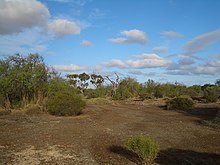
Environmental degradation is the deterioration of the environment through depletion of resources such as quality of air, water and soil; the destruction of ecosystems; habitat destruction; the extinction of wildlife; and pollution. It is defined as any change or disturbance to the environment perceived to be deleterious or undesirable.[39][40] The environmental degradation process amplifies the impact of environmental issues which leave lasting impacts on the environment.[41]
Environmental degradation is one of the ten threats officially cautioned by the High-level Panel on Threats, Challenges and Change of the United Nations. The United Nations International Strategy for Disaster Reduction defines environmental degradation as "the reduction of the capacity of the environment to meet social and ecological objectives, and needs".[42]
Environmental degradation comes in many types. When natural habitats are destroyed or natural resources are depleted, the environment is degraded; direct environmental degredation, such as deforestation which has readily visible; this can be caused by more indirect process, such as the build up of plastic pollution over time or the buildup of greenhouse gases that causes tipping points in the climate system. Efforts to counteract this problem include environmental protection and environmental resources management. Mismanagement that leads to degradation can also lead to environmental conflict where communities organize in opposition to the forces that mismanaged the environment.Conflict

Environmental conflicts, socio-environmental conflict or ecological distribution conflicts (EDCs) are social conflicts caused by environmental degradation or by unequal distribution of environmental resources.[43][44][45] The Environmental Justice Atlas documented 3,100 environmental conflicts worldwide as of April 2020 and emphasised that many more conflicts remained undocumented.[43]
Parties involved in these conflicts include locally affected communities, states, companies and investors, and social or environmental movements;[46][47] typically environmental defenders are protecting their homelands from resource extraction or hazardous waste disposal.[43] Resource extraction and hazardous waste activities often create resource scarcities (such as by overfishing or deforestation), pollute the environment, and degrade the living space for humans and nature, resulting in conflict.[48] A particular case of environmental conflicts are forestry conflicts, or forest conflicts which "are broadly viewed as struggles of varying intensity between interest groups, over values and issues related to forest policy and the use of forest resources".[49] In the last decades, a growing number of these have been identified globally.[50]
Frequently environmental conflicts focus on environmental justice issues, the rights of indigenous people, the rights of peasants, or threats to communities whose livelihoods are dependent on the ocean.[43] Outcomes of local conflicts are increasingly influenced by trans-national environmental justice networks that comprise the global environmental justice movement.[43][51]
Environmental conflict can complicate response to natural disaster or exacerbate existing conflicts – especially in the context of geopolitical disputes or where communities have been displaced to create environmental migrants.[52][45][48] The study of these conflicts is related to the fields of ecological economics, political ecology, and environmental justice.Costs
Action
Justice
Environmental justice or eco-justice, is a social movement to address environmental injustice, which occurs when poor or marginalized communities are harmed by hazardous waste, resource extraction, and other land uses from which they do not benefit.[53][54] The movement has generated hundreds of studies showing that exposure to environmental harm is inequitably distributed.[55]
The movement began in the United States in the 1980s. It was heavily influenced by the American civil rights movement and focused on environmental racism within rich countries. The movement was later expanded to consider gender, international environmental injustice, and inequalities within marginalised groups. As the movement achieved some success in rich countries, environmental burdens were shifted to the Global South (as for example through extractivism or the global waste trade). The movement for environmental justice has thus become more global, with some of its aims now being articulated by the United Nations. The movement overlaps with movements for Indigenous land rights and for the human right to a healthy environment.[56]
The goal of the environmental justice movement is to achieve agency for marginalised communities in making environmental decisions that affect their lives. The global environmental justice movement arises from local environmental conflicts in which environmental defenders frequently confront multi-national corporations in resource extraction or other industries. Local outcomes of these conflicts are increasingly influenced by trans-national environmental justice networks.[57][58]
Environmental justice scholars have produced a large interdisciplinary body of social science literature that includes contributions to political ecology, environmental law, and theories on justice and sustainability.[54][59][60]The 2023 IPCC report highlighted the disproportionate effects of climate change on vulnerable populations. The report's findings make it clear that every increment of global warming exacerbates challenges such as extreme heatwaves, heavy rainfall, and other weather extremes, which in turn amplify risks for human health and ecosystems. With nearly half of the world's population residing in regions highly susceptible to climate change, the urgency for global actions that are both rapid and sustained is underscored. The importance of integrating diverse knowledge systems, including scientific, Indigenous, and local knowledge, into climate action is highlighted as a means to foster inclusive solutions that address the complexities of climate impacts across different communities.[61]
In addition, the report points out the critical gap in adaptation finance, noting that developing countries require significantly more resources to effectively adapt to climate challenges than what is currently available. This financial disparity raises questions about the global commitment to equitable climate action and underscores the need for a substantial increase in support and resources. The IPCC's analysis suggests that with adequate financial investment and international cooperation, it is possible to embark on a pathway towards resilience and sustainability that benefits all sections of society.[61]
Law
Assessment
Environmental Impact assessment (EIA) is the assessment of the environmental consequences of a plan, policy, program, or actual projects prior to the decision to move forward with the proposed action. In this context, the term "environmental impact assessment" is usually used when applied to actual projects by individuals or companies and the term "strategic environmental assessment" (SEA) applies to policies, plans and programmes most often proposed by organs of state.[65][66] It is a tool of environmental management forming a part of project approval and decision-making.[67] Environmental assessments may be governed by rules of administrative procedure regarding public participation and documentation of decision making, and may be subject to judicial review.
The purpose of the assessment is to ensure that decision-makers consider the environmental impacts when deciding whether or not to proceed with a project. The International Association for Impact Assessment (IAIA) defines an environmental impact assessment as "the process of identifying, predicting, evaluating and mitigating the biophysical, social, and other relevant effects of development proposals prior to major decisions being taken and commitments made".[68] EIAs are unique in that they do not require adherence to a predetermined environmental outcome, but rather they require decision-makers to account for environmental values in their decisions and to justify those decisions in light of detailed environmental studies and public comments on the potential environmental impacts.[69]Movement

The environmental movement (sometimes referred to as the ecology movement), is a social movement that aims to protect the natural world from harmful environmental practices in order to create sustainable living.[70] Environmentalists advocate the just and sustainable management of resources and stewardship of the environment through changes in public policy and individual behavior.[71] In its recognition of humanity as a participant in (not an enemy of) ecosystems, the movement is centered on ecology, health, as well as human rights.
The environmental movement is an international movement, represented by a range of environmental organizations, from enterprises to grassroots and varies from country to country. Due to its large membership, varying and strong beliefs, and occasionally speculative nature, the environmental movement is not always united in its goals. At its broadest, the movement includes private citizens, professionals, religious devotees, politicians, scientists, nonprofit organizations, and individual advocates like former Wisconsin Senator Gaylord Nelson and Rachel Carson in the 20th century.Organizations
Environmental issues are addressed at a regional, national or international level by government organizations.
The largest international agency, set up in 1972, is the United Nations Environment Programme. The International Union for Conservation of Nature brings together 83 states, 108 government agencies, 766 Non-governmental organizations and 81 international organizations and about 10,000 experts, scientists from countries around the world.[72] International non-governmental organizations include Greenpeace, Friends of the Earth and World Wide Fund for Nature. Governments enact environmental policy and enforce environmental law and this is done to differing degrees around the world.
Film and television
There are an increasing number of films being produced on environmental issues, especially on climate change and global warming. Al Gore's 2006 film An Inconvenient Truth gained commercial success and a high media profile.
See also
- Citizen science
- Ecotax
- Environmental impact statement
- Index of environmental articles
- Triple planetary crisis
Issues
- List of environmental issues (includes mitigation and conservation)
Specific issues
- Environmental impact of agriculture
- Environmental impact of aviation
- Environmental impact of reservoirs
- Environmental impact of the energy industry
- Environmental impact of fishing
- Environmental impact of irrigation
- Environmental impact of mining
- Environmental impact of paint
- Environmental impact of paper
- Environmental impact of pesticides
- Environmental implications of nanotechnology
- Environmental impact of shipping
- Environmental impact of war
References
Works cited
- Chapin, F. Stuart; Matson, Pamela A.; Vitousek, Peter (September 2, 2011). Principles of Terrestrial Ecosystem Ecology. Springer Science+Business Media. ISBN 978-1-4419-9504-9. Retrieved October 4, 2022.
- Hawksworth, David L.; Bull, Alan T. (2008). Biodiversity and Conservation in Europe. Springer. p. 3390. ISBN 978-1402068645.
- Sahney, S.; Benton, M.J.; Ferry, P.A. (2010). "Links between global taxonomic diversity, ecological diversity and the expansion of vertebrates on land". Biology Letters. 6 (4): 544–547. doi:10.1098/rsbl.2009.1024. PMC 2936204. PMID 20106856.
- Steffen, Will; Sanderson, Regina Angelina; Tyson, Peter D.; Jäger, Jill; Matson, Pamela A.; Moore III, Berrien; Oldfield, Frank; Richardson, Katherine; Schellnhuber, Hans-Joachim (January 27, 2006). Global Change and the Earth System: A Planet Under Pressure. Springer Science+Business Media. ISBN 978-3-540-26607-5. Retrieved October 4, 2022.
- Ferguson, Robert (1999). Environmental Public Awareness Handbook: Case Studies and Lessons Learned in Mongolia. Ulaanbaatar: DSConsulting. ISBN 99929-50-13-7.
External links
 Media related to Environmental problems at Wikimedia Commons
Media related to Environmental problems at Wikimedia Commons
